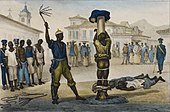
Back Colp amb bastó Catalan Bastunèda EML چوبزنی Persian Kepitys Finnish Coup de canne French Hukuman pukulan rotan ID Bastonatura Italian 笞罪 Japanese 매질 (체벌) Korean Hukuman sebat Malay
This article needs additional citations for verification. (December 2014) |
| Part of a series on |
| Corporal punishment |
|---|
 |
| By place |
| By implementation |
| By country |
| Court cases |
| Politics |
| Campaigns against corporal punishment |

Caning is a form of corporal punishment consisting of a number of hits (known as "strokes" or "cuts") with a single cane usually made of rattan, generally applied to the offender's bare or clothed buttocks (see spanking) or hands (on the palm). Caning on the knuckles or shoulders is much less common. Caning can also be applied to the soles of the feet (foot whipping or bastinado). The size and flexibility of the cane and the mode of application, as well as the number of the strokes, may vary.
Flagellation as punishment was so common in England that caning, along with spanking and whipping, were called "le vice anglais" or "the English vice".[1] Caning can also be done consensually as part of BDSM.
The thin cane generally used for corporal punishment is not to be confused with the walking stick, which is sometimes also called cane (especially in American English), but is thicker and much more rigid, and usually made of stronger wood.
- ^ Thomas Edward Murray; Thomas R. Murrell (1989). The Language of Sadomasochism: A Glossary and Linguistic Analysis. ABC-CLIO. pp. 23–. ISBN 978-0-313-26481-8.